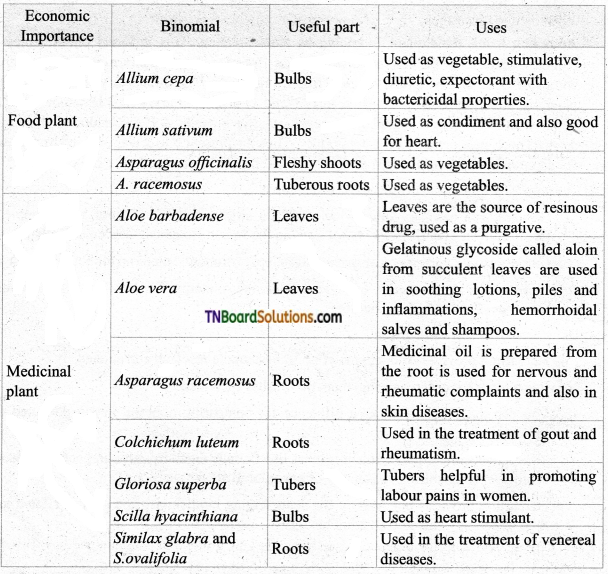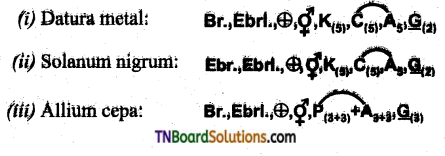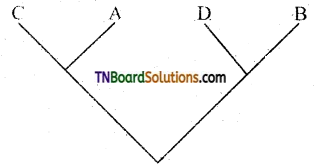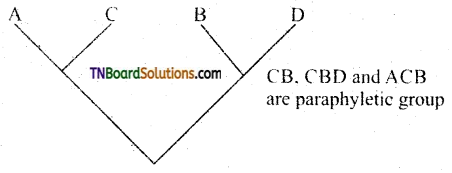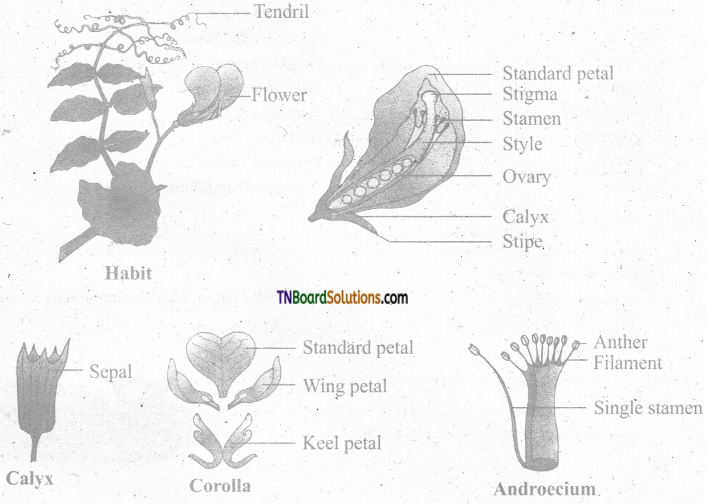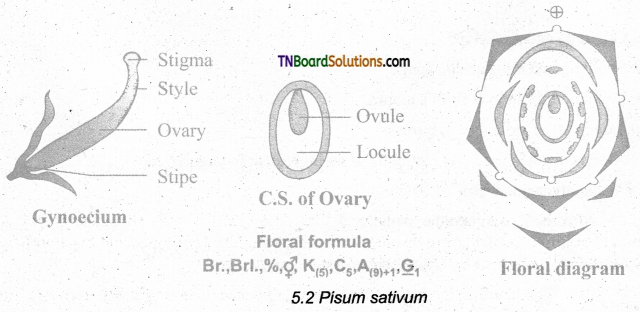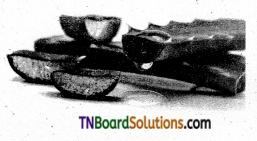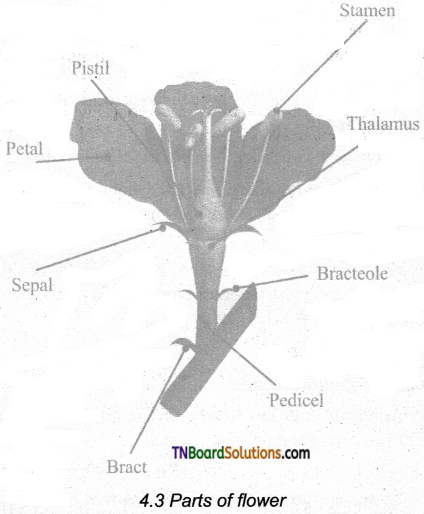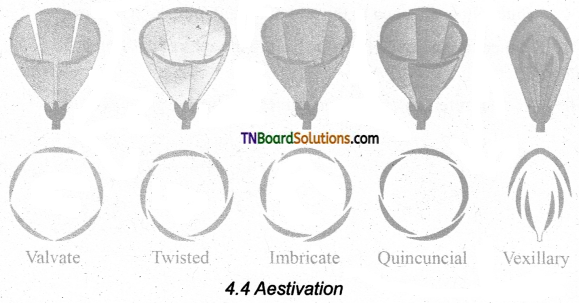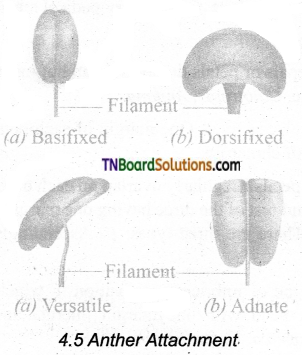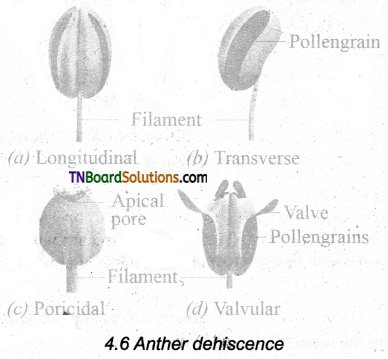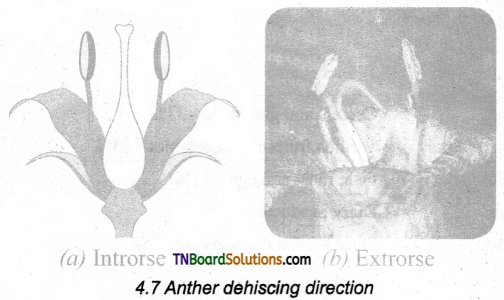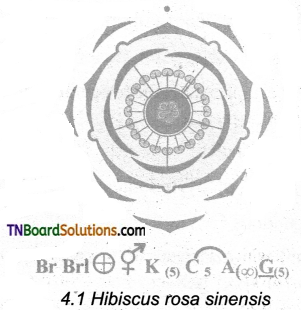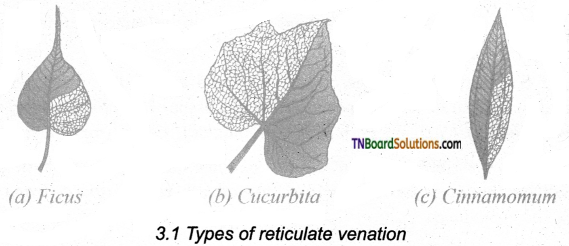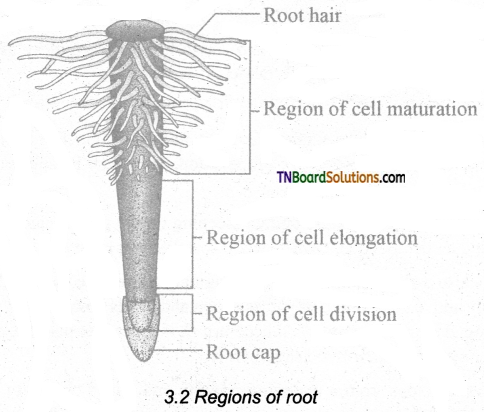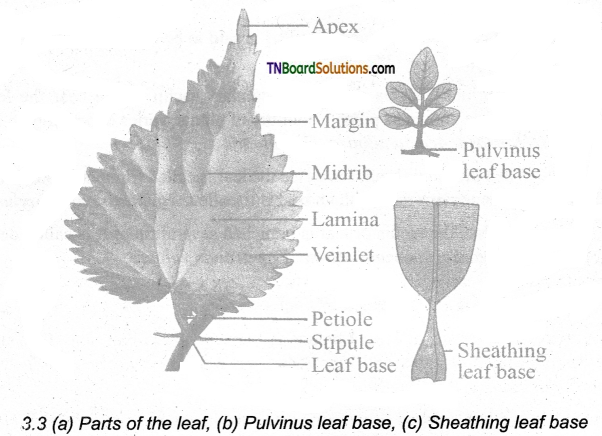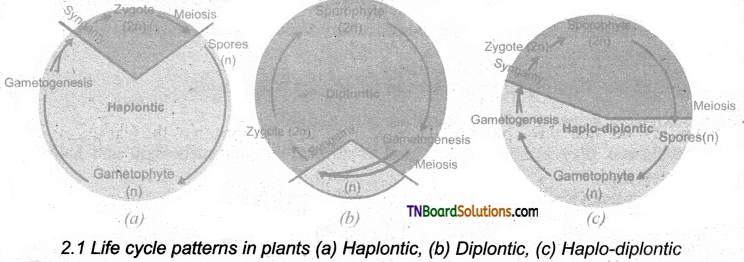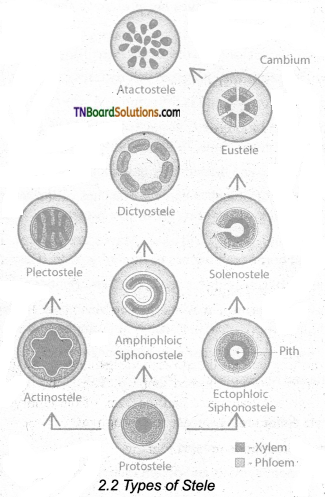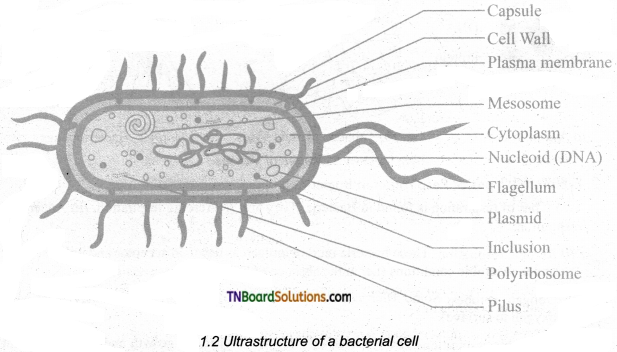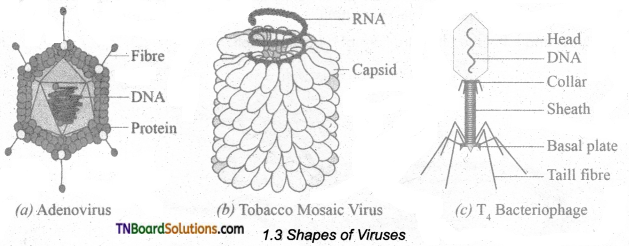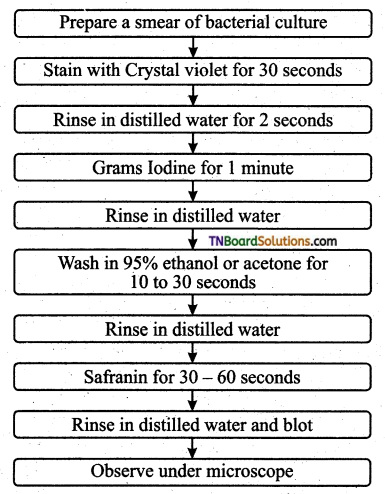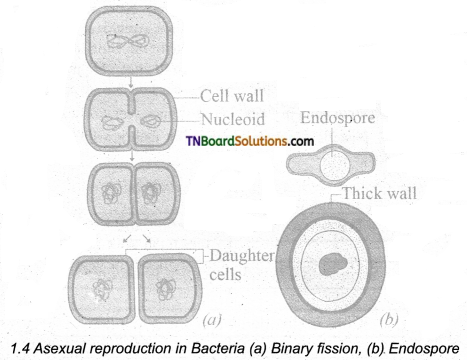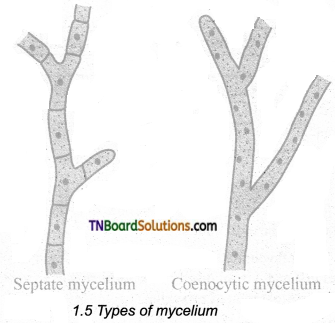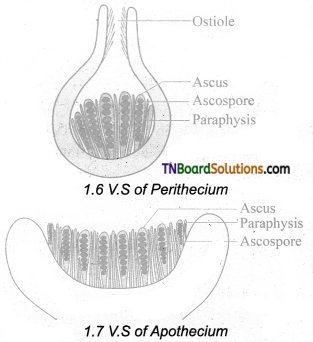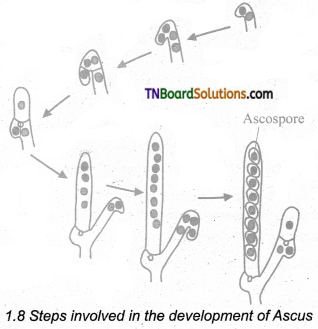Students get through the TN Board 11th Bio Botany Important Questions Chapter 6 Cell: The Unit of Life which is useful for their exam preparation.
TN State Board 11th Bio Botany Important Questions Chapter 6 Cell: The Unit of Life
Answer the following short answers.
Question 1.
What is primary magnification?
Answer:
The first magnification of the microscope is done by the objective lens which is called primary magnification.
Question 2.
Name the two kinds of an electron microscope.
Answer:
There are two kinds of electron microscopes namely:
- Transmission Electron Microscope (TEM).
- Scanning Electron Microscope (SEM).
Question 3.
What is the main use of TEM?
Answer:
This is the most commonly used electron microscope that provides two-dimensional images. The components of the microscope are as follows: (i) Electron Generating System, (ii) Electron Condenser, (Hi) Specimen Objective, (iv) Tube Lens, (v) Projector. It is used for studying the detailed structure of viruses, mycoplasma, cellular organelles, etc.
![]()
Question 4.
List out the name of microscopes in which the light of illumination is visible light.
Answer:
Light Microscope, Darkfield Microscopy, Phase contrast Microscope.
Question 5.
What are the constituents of protoplasm?
Answer:
It is primarily made of water contents and various other solutes of biological importance such as glucose,fatty acids, amino acids, minerals,vitamins, hormones and enzyme.
Question 6.
Define cohesiveness of protoplasm.
Answer:
Particles or molecules of protoplasm are adhered with each other by forces, such as Vander Waal’s bonds, that hold long chains of molecules together.
Question 7.
Nome the three types of cells.
Answer:
The three types of cells are Prokaryotes, Mesokaryotes, and Eukaryotes.
Question 8.
Define mesokoryotes.
Answer:
These organisms share some of the characters of both prokaryotes and eukaryotes. In other words, these are organisms intermediate between pro and eukaryotes.
![]()
Question 9.
Explain primary cell wall.
Answer:
It is the first layer of inner to middle lamellae, primarily consisting of a loose network of cellulose microfibrils in a gel matrix. It is thin, elastic, and extensible.
Question 10.
How does a ‘glycocalyx’ form?
Answer:
The Carbohydrate molecules of the cell membrane are short-chain polysaccharides. These are either bound with ‘glycoproteins’ or ‘glycolipids’ and form a glycocalyx.
Question 11.
Define Endocytosis and exocytosis.
Answer:
Cell surface membranes are able to transport individual molecules and ions. There are processes in which a cell can transport a large number of solids and liquids into the cell (endocytosis) or out of the cell (exocytosis).
Question 12.
What do you understand by the term phagocytosis?
Answer:
The particle is engulfed by a membrane, which folds around it and forms a vesicle. The enzymes digest the material and products are absorbed by cytoplasm.
![]()
Question 13.
Define cristae of mitochondria.
Answer:
The inner membrane is convoluted (infoldings), called the crista (plural: cristae). Cristae contain most of the enzymes for the electron transport system.
Question 14.
Name any three odors plastids.
Answer:
The three odors plastids are Chloroplast, Phaeoplast, Rhodoplast.
Question 15.
What is the main function of polysome?
Answer:
The function of polysomes in the formation of several copies of a particular polypeptide during protein synthesis.
Question 16.
What are Glyoxysomes?
Answer:
Glyoxysome is a single membrane-bound organelle. It is a sub-cellular organelle and contains enzymes of glyoxylate pathway, fi-oxidation of fatty acid occurs in glyoxysomes of germinating seeds, eg. Castor seeds.
Question 17.
What is the main function of .plant vacuoles?
Answer:
The major function of plant vacuole is to maintain water pressure known as turgor pressure, which maintains the plant structure. Vacuoles organize themselves into a storage/sequestration compartment.
![]()
Question 18.
What are the reserve materials present in prokaryotes?
Answer:
In prokaryotes, reserve materials such as phosphate granules, cyanophycean granules, glycogen granules, poly-hydroxy butyrate granules, sulfur granules, carboxysomes, and gas vacuoles are present.
Question 19.
Explain briefly the Holocentric chromosomes.
Answer:
Holocentric chromosomes have centromere activity distributed along the whole surface of the chromosome during mitosis. The holocentric condition can be seen in Caenorhabditis elegans (transparent nematode) Mid many insects.
Question 20.
What do you know about microphotographs?
Answer:
Images of structures observed through microscopes can be further magnified, projected, and saved by attaching a camera to the microscope by a microscope coupler or; eyepiece adaptor. Picture taken using an inbuilt camera in a microscope is called microphotography or microphotograph.
![]()
Answer In brief.
Question 1.
Describe briefly the Darkfield microscope.
Answer:
- The darkfield microscope was discovered by Z. Sigmondy (1905). Here the field will be dark but the object will be glistening so the appearance will be bright.
- A special effect in an ordinary microscope is brought about by means of a special component called Patch Stop Carrier’.
- It is fixed in the metal ring of the condenser component
- Patch top is a small glass device that has a dark patch at the center of the disc leaving a small area along the margin through which the light passes.
- The light passing through the margin will travel oblique like a hollow cone and strikes the object in the periphery, therefore the specimen appears glistening in a dark background.
Question 2.
Explain the principle and function of a scanning electron microscope.
Answer:
- This is used to obtain the three-dimensional image and has a lower resolving power than TEM.
In this, electrons are focused by means of lenses into a very fine point. - The interaction of electrons with the specimen results in the release of different forms of radiation (such as Auger electrons, secondary electrons, backscattered electrons) from the surface of the specimen.
- These radiations are then captured by an appropriate detector, amplified, and then imaged on a fluorescent screen.
- The magnification is. 2,00,000 times and resolution is 5-20 nm.
Question 3.
Enumerate the functions of the cell wall.
Answer:
- Offers definite shape and rigidity to the cell.
- Serves as a barrier for several molecules to enter the cells.
- Provides protection to the internal protoplasm against mechanical injury.
- Prevents the bursting of cells by maintaining the osmotic pressure.
- Plays a major role by acting as a mechanism of defense for the cells.
![]()
Question 4.
What do you know about signal transduction in cells? Explain briefly.
Answer:
- The process by which the cell receives information from outside and responds is called signal transduction.
- Plants, fungi, and animal cells use nitric oxide as one of the many signaling molecules.
- The cell membrane is the site of chemical interactions of signal transduction.
- Receptors receive the information from the first messenger and transmit the message through series of membrane proteins.
- It activates a second messenger which stimulates the cell to carry out specific functions.
Question 5.
List out the functions of Golgi bodies.
Answer:
- Glycoproteins and glycolipids are produced.
- Transporting and storing lipids.
- Formation of lysosomes.
- Production of digestive enzymes.
- Cell plate and cell wall formation
- Secretion of Carbohydrates for the formation of plant cell walls and insect cuticles.
Question 6.
How do the grana in chloroplast form? Mention their structure and function.
Answer:
- Grana (singular: Granum) are formed when many of these thylakoids are stacked together
like a pile of coins. - Light is absorbed and converted into chemical energy in the granum, which is used in the stroma to prepare carbohydrates. Thylakoids contain chlorophyll pigments.
- The chloroplast contains osmophilic granules, 70s ribosomes, DNA (circular and non-histone), and RNA.
- This chloroplast genome encodes approximately 30 proteins involved in photosynthesis including the components of photosystem I & II, cytochrome bf complex, and ATP synthase.
- One of the subunits of Rubisco is encoded by chloroplast DNA.
- It is the major protein component of chloroplast stroma, the single most abundant protein on earth.
- The thylakoid contains small, rounded photosynthetic units called quantosomes.
- It is a semi-autonomous organelle and divides by fission.
![]()
Question 7.
Explain the types of chromosomes based on the position of the centromere.
Answer:
- Based on the position of the centromere, chromosomes are called telocentric (terminal centromere), Acrocentric (terminal centromere capped by telomere), Sub metacentric
- The eukaryotic chromosomes may be tod-shaped (telocentric and acrocentric), L-shaped (sub-metacentric), and V-shaped (metacentric).
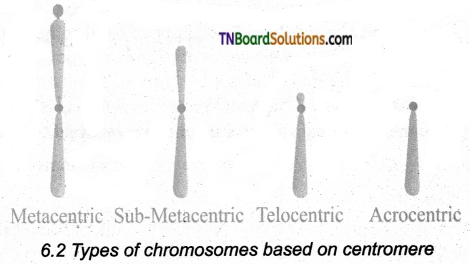
Question 8.
Describe the structure of flagellum in bacteria.
Answer:
The gram-positive bacteria contain only two basal rings. S-ring is attached to the inside of peptidoglycan and M-ring is attached to the cell membrane. In Gram-negative bacteria, two pairs of rings proximal and distal ring are connected by a central rod. They are L- Lipopolysacchride ring P- Peptidoglycan ring, S-Super membrane ring, and M-membrane ring. The outer pair of L and P rings are attached to the cell wall and the inner pair of S and M rings attached to the cell membrane.
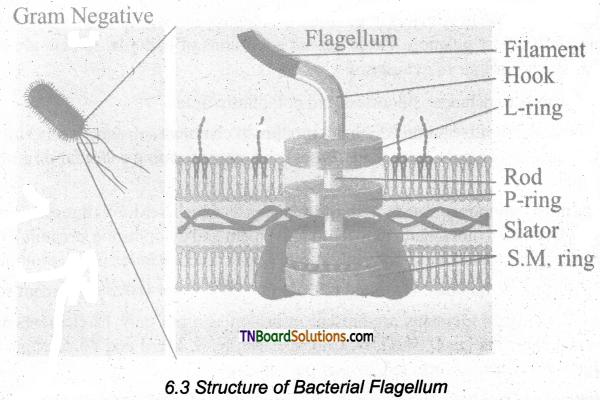
![]()
Question 9.
Explain the structure and function of Cilia.
Answer:
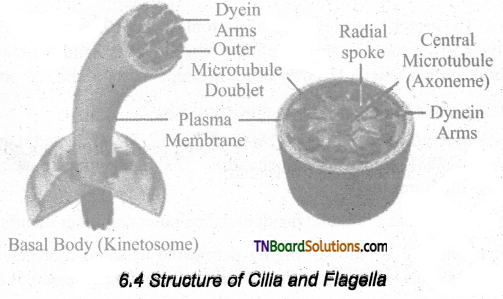
Cilia (plural) are short cellular, numerous microtubule bound projections of the plasma membrane.
Cilium (singular) is a membrane-bound structure made up of basal body, rootlets, basal plate, and shaft. The shaft or axoneme consists of nine pairs of microtubule doublets, arranged in a circle along the die periphery with two central tubules, (9 + 2) arrangement of microtubules is present. Microtubules are made up of tubulin. The motor protein dynein connects the outer microtubule pair and links them to the central pair. Nexin links the peripheral doublets of microtubules.
Answer In detail.
Question 1.
Enumerate the physical properties of protoplasm.
Answer:
Physical Properties of Protoplasm: The protoplasm exists either in a semisolid (jelly-like) state called ‘gel’ due to suspended particles and various chemical bonds or maybe a liquid state called ” ‘sol’.
The colloidal protoplasm which is in gel form can change into sol form by solation and the sol can change into a gel by gelation. These gel-sol conditions of the colloidal system are the prime basis for the mechanical behavior of cytoplasm.
- Protoplasm is translucent, odorless, and polyphasic fluid.
- It is a crystal colloid solution which is a mixture of chemical substances forming crystalloid
i.e. true solution (sugars, salts, acids, bases) and others forming colloidal solution (Proteins and lipids). - It is the most important property of the protoplasm by which it exhibits three main phenomena namely Brownian movement, amoeboid movement, and cytoplasmic streaming or cyclosis.
The viscosity of protoplasm is 2-20 centipoises. The Refractive index of the protoplasm is 1.4. - The pH of the protoplasmic around 6.8, contains 90% water (10% in dormant seeds)
- Approximately 34 elements are present in protoplasm but only 13 elements are main or universal elements i.e. C, H, O, N, Cl, Ca, P, Na, K, S, Mg, I, and Fe. Carbon, Hydrogen, Oxygen, and Nitrogen form 96% of protoplasm.
- Protoplasm is neither a good nor a bad conductor of electricity. It forms a delimiting the membrane on coming in contact with water and solidifies when heated.
Cohesiveness: Particles or molecules of protoplasm are adhered with each other by forces, such as Vander Waal’s bonds, that hold long chains of molecules together. This property varies with the strength of these forces.
Contractility: The contractility of protoplasm is important for the absorption and removal of water especially stomatal operations.
Surface tension: The proteins and lipids of the protoplasm have less surface tension, hence they are found at the surface forming the membrane. On the other hand, the chemical substances (NaCl) have high surface tension, so they occur in deeper parts of the cell protoplasm.
![]()
Question 2.
Describe the structure and function of mitochondria.
Answer:
- It was first observed by A. Kolliker (1880). Altmann (1894) named it as Bioplasts. Later Benda (1897, 1898), named as mitochondria. They are ovoid, rounded, rod shape and pleomorphic structures.
- Mitochondrion consists of a double membrane, the outer and inner membrane.
- The outer membrane is smooth, highly permeable to small molecules and it contains proteins called Porins, which form channels that allow free diffusion of molecules smaller than about 1000 daltons and the inner membrane divides the mitochondrion into two compartments, the outer chamber between two membranes and the inner chamber filled with matrix.
- The inner membrane is convoluted (infoldings), called the crista (plural: cristae). Cristae contain most of the enzymes for the electron transport system.
- The inner chamber of the mitochondrion is filled with proteinaceous material called mitochondrial matrix.
- The inner membrane consists of stalked particles called elementary particles or Fernandez Moran particles, F1 particles, or Oxysomes.
- Each particle consists of a base, stem, and round head. In the head, ATP synthase is present for oxidative phosphorylation.
- The inner membrane is impermeable to most ions, small molecules and maintains the proton gradient that drives oxidative phosphorylation.
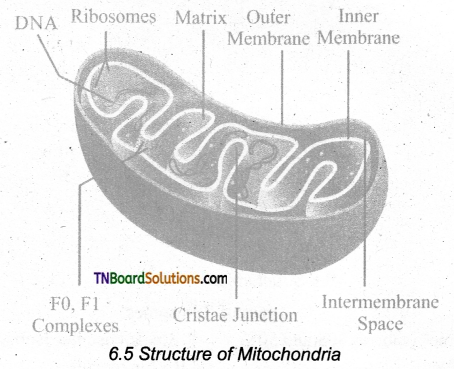
- Mitochondria contain 73% of proteins, 25-30% of lipids, 5-7 % of RNA, DNA (in traces), and enzymes (about 60 types).
- Mitochondria are called the Powerhouse of a cell, as they produce energy-rich ATP.
- All the enzymes of Kreb’s cycle are found in the matrix except succinate dehydrogenase. Mitochondria consist of circular DNA and 70S ribosome.
- They multiply by fission and replicates by strand displacement model. Because of the presence of DNA, it is a semi-autonomous organelle.
- The unique characteristic of mitochondria is that they are inherited from female parents only. Mitochondrial DNA comparisons are used to trace human origins.
- Mitochondrial DNA is used to track and date recent evolutionary times because it mutates 5 to 10 times faster than DNA in the nucleus.
![]()
Question 3.
Explain the structure of Ribosomes. Mention the types of ribosomes.
Answer:
Ribosomes were first observed by George Palade (1953) as dense particles or granules in the electron microscope. Electron microscopic observation reveals that ribosomes are composed of two rounded subunits, united together to form a complete unit. Mg2+ is required for the structural cohesion of ribosomes. Biogenesis of ribosomes is de nova formation, auto replication, and nucleolar origin. Each ribosome is made up of one small and one large subunit. Ribosomes are the sites of protein synthesis in the cell. The ribosome is not a membrane-bound organelle.
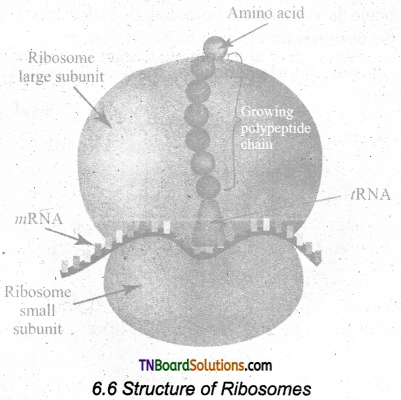
| Types of Ribosomes | |
| 70S Ribosomes (subunit 30S and 50S) | 80S Ribosomes (subunits 40S and 60S) |
| 3 RNA molecule. | 4 RNA molecule. |
| (i) 16SrRNA in 30S subunit. | (i) 18SrRNA in 40S small subunit. |
| (ii) 23S and 5Sin SOS large subunit. Prokaryotic cells of Blue-green algae Bacteria, Mitochondria, and Chloroplast of many Algae and higher plants. | (ii) 28S, 5.8S, and 5S in larger 60S subunit. Eukaryotic cells of Plants and animals |
Question 4.
Give details of the special types of chromosomes in plant and animal cells.
Answer:
- Special types of chromosomes are found only in certain special tissues. These chromosomes are larger in size and are called giant Chromosomes in certain plants and they are found in the suspensors of the embryo.
- The polytene chromosome and lampbrush chromosome occur in animals and are also called giant chromosomes.
- Polytene chromosomes observed in the salivary glands of Drosophila (fruit fly) by C.G. Balbiani in 1881. In larvae of many flies, midges (Diptera), and some insects the interphase chromosomes duplicate and reduplicate without nuclear division.
- A single chromosome that is present in multiple copies forms a structure called a polytene chromosome which can be seen in the light microscope.
- They are genetically active. There are distinct alternating dark bands and light inter-bands. About 95%of DNA are present in bands and 5% in inter-bands. The polytene chromosome has extremely large puff called Balbiani rings which is seen in chironortious larvae. It is also known as chromosomal puff. Puffing of bands are the sites of intense RNA synthesis,
- As this chromosome occurs in the salivary gland it is known as salivary gland chromosomes, Polyteny is achieved by repeated replication of chromosomal DNA several times without nuclear division and the daughter chromatids aligned side by side and do not separate (called endomitosis).
- Gene expression, transcription of genes, and RNA synthesis occur in the bands along the polytene chromosomes. Maternal and paternal homologs remain associated side by side is called somatic pairing.
- Lampbrush chromosomes occur at the diplotene stage of the first meiotic prophase in oocytes of an animal Salamandar and in the giant nucleus of the unicellular alga Acetabularia.
- It was first observed by Flemming in 1882. The highly condensed chromosome forms the chromosomal axis, from which lateral loops of DNA extend as a result of intense RNA synthesis.
![]()
Question 5.
Describe the structure of eukaryotic flagella and explain the movement of the flagellum.
Answer:
- Eukaryotic Flagella are enclosed by a unit membrane and it arises from a basal body Flagella is composed of outer nine pairs of microtubules with two microtubules in its center (9+2 arrangement).
- Flagella are microtubule projections of the plasma membrane. The flagellum is longer than cilium (as long as 200pm). The structure of the flagellum has an axoneme made up of microtubules and protein tubulin.
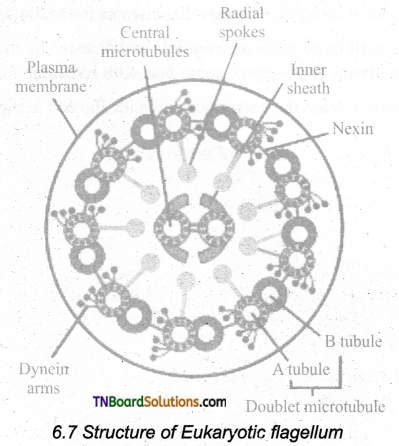
- Movement: Outer microtubule doublet is associated with axonemal dynein which generates force for movement. The movement is ATP-driven. The interaction between tubulin and dynein is the mechanism for the contraction of cilia and flagella. Dynein molecules use energy from ATP to shift the adjacent microtubules. This movement bends the cilium or flagellum.
Question 6.
Describe the structure and functions of Lysosomes.
Answer:
Lysosomes were discovered by Christian de Duve (1953), these are known as suicidal bags. They are spherical bodies enclosed by a single unit membrane. They are found in eukaryotic cells. Lysosomes are small vacuoles formed when small pieces of the Golgi body are pinched off from its tubules.
They contain a variety of hydrolytic enzymes, that can digest material within the cell. The membrane around the lysosome prevents these enzymes from digesting the cell itself.
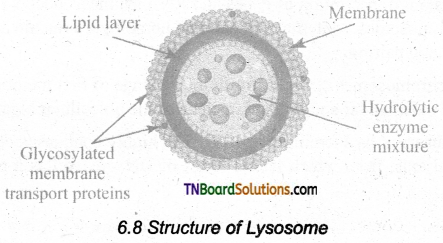
Functions:
Intracellular digestion: They digest carbohydrates, proteins, and lipids present in the cytoplasm.
Autophagy: During the adverse condition, they digest their own cell organelles like mitochondria and endoplasmic reticulum
Autolysis: Lysosome causes self-destruction of cells on the insight of disease they destroy the cells.
Ageing Lysosomes have autolytic enzymes that disrupt intracellular molecules.
Phagocytosis: Large cells or contents are engulfed and digested by macrophages, thus forming a phagosome in the cytoplasm. These phago some fuse with lysosome for further digestion.
Exocytosis: Lysosomes release their enzymes outside the cell to digest other cells.
![]()
Choose the correct answer.
1. The word cell was first used by:
(a) Robert brown
(b) Robert Hooke
(c) Zemike
(d) Robert schwann
Answer:
(b) Robert Hooke
2. Idea of cell theory was first proposed by:
(a) Matthias Schleiden
(b) Theodor schwann
(c) H.J. Dutrochet
(d) Rudolf Virchow
Answer:
(c) H.J. Dutrochet
3. Phase the contrast microscope was invented by:
(a) Zemike
(b) Robert brown
(c) Sigmondy
(d) Robert Hooke
Answer:
(a) Zemike
4. Source of illumination for image formation in dark field microscope is:
(a) Electron
(b) ultraviolet light
(c) X- rays
(d) Visible light
Answer:
(d) Visible light
![]()
5. Who coined the term “protoplasm”?
(a) Corti
(b) Van mohl
(c) Purkinje
(d) Fisher
Answer:
(c) Purkinje
6. Indicate the wrong statement:
(a) All organisms are made up of cells
(b) All metabolic reactions take place inside the cell
(c) The structure and function of the cell is controlled by DNA
(d) Group of cells with different structures are called tissue
Answer:
(d) Group of cells with different structures are called tissue
7. Approximately the number of elements present in protoplasm is:
(a) 28
(b) 34
(c) 38
(d) 24
Answer:
(b) 34
8. These organisms with the primitive nucleus are called:
(a) Mesokaryotes
(b) prokaryotes
(c) Eukaryotes
(d) None of the above
Answer:
(b) prokaryotes
![]()
9. Cell wall is not present in:
(a) Bacteria
(b) Fungi
(c) Animal cell
(d) plant cell
Answer:
(c) Animal cell
10. The carbohydrate molecules of the cell membrane are:
(a) Long-chain polysaccharides
(b) Short-chain polysaccharides
(c) Long-chain glycoproteins
(d) Short-chain glycolipids.
Answer:
(b) Short-chain polysaccharides
11. One of the many signaling molecules used by plants, fungi, and animal cell is:
(a) sodium chloride
(b) cupric oxide
(c) Nitric oxide
(d) None of the above
Answer:
(c) Nitric oxide
12. Cytoplasm helps the movement of cellular materials around die cell through a process called:
(a) Cytoplasmic streaming
(b) Brownian movement
(c) Active movement
(d) none of the above
Answer:
(a) Cytoplasmic streaming
13. The name endoplasmic reticulum was given by:
(a) Camillo
(b) K.R.Porter
(c) Nickolson
(d) S.B.Roberts
Answer:
(b) K.R.Porter
![]()
14. The functions of the Golgi body includes:
(a) helping cell division
(b) initialing protein synthesis
(c) Transporting and storing lipids
(d) None of the above
Answer:
(c) Transporting and storing lipids
15. Mitochondria are called the powerhouse of the cell as they:
(a) Synthesis lipid
(b) Involve in protein synthesis
(c) initiate oxidation metabolism
(d) Produce energy-rich ATP
Answer:
(d) Produce energy-rich ATP
16. Mitochondrial DNA mutates …………. times faster than DNA in the nucleus.
(a) 15 to 20
(b) 30 to 40
(c) 5 to 10
(d) 10 to 15
Answer:
(c) 5 to 10
17. Plastids were classified into various types according to their structure pigments and function:
(a) Robert Hooke
(b) A.F.tJ. Schimper
(c) A. Kolliker
(d) Altmann
Answer:
(b) A.F.tJ. Schimper
![]()
18. B – oxidation of fully acids occurs in glyoxysomes of germinating seeds of:
(a) Paddy
(b) Brinjal
(c) Ladies finger
(d) Caster
Answer:
(d) Caster
19. Centriole consists of nine triplet peripheral fibrils made up of
(a) tubulin
(b) fibrils
(c) annuli
(d) none of the above.
Answer:
(a) tubulin
20. Match the following:
| Column-I | Column-II |
| (i) Thylakoids | (a) Disc-shaped sacs in Golgi apparatus. |
| (ii) Cristae | (b) Condensed structure of DNA. |
| (iii) Cistemae | (c) Flat membranous sacs in stroma. |
| (iv) Chromatin | (d) Infoldings in mitochondria. |
(a) (i)-(d), (ii)-(b), (iii)-(a), (iv)-(c)
(b) (i)-(c), (ii)-(d), (iii)-(a), (iv)-(b)
(c) (i)-(b), (ii)-(a), (iii)-(d), (iv)-(c)
(d) (i)-(b), (ii)-(c), (iii)-(a), (iv)-(d)
Answer:
(b) (i)-(c), (ii)-(d), (iii)-(a), (iv)-(b)
![]()
21. During cell division, chromation is condensed into an organised form called:
(a) nucleolus
(b) Euchromation
(c) Nuclear pores
(d) Chromosomes
Answer:
(d) Chromosomes
22. Chromatin is made up of
(a) DNA, Polysaccharides, and RNA
(b) DNA, lipids, and RNA
(c) DNA, protein, and RNA
(d) RNA, Glucose, and lipid
Answer:
(c) DNA, protein, and RNA
23. Chromosomes having terminal centromere are called:
(a) Acrocentric
(b) Telocentric
(c) Metacentric
(d) Submetacentric
Answer:
(b) Telocentric
24. Polytene chromosome in the salivary glands of drosophila was first observed by:
(a) Flemming
(b) C.G. Balbiani
(c) Harry Beevers
(d) A. Kolliker
Answer:
(b) C.G. Balbiani
![]()
25. Lampbrush chromosome occur at the diplotene stage of first meiotic prophase in oocytes of:
(a) Frog
(b) Moth
(c) Sherk
(d) Salamandra
Answer:
(d) Salamandra
26. The main function of Bacterial flagellum is:
(a) Locomotion
(b) Protection
(c) Feeding
(d) none of the above
Answer:
(a) Locomotion
27. The molecules involved in the mechanism for the contraction of cilia and flagella are:
(a) Aetin and peptin
(b) Flagellin
(c) Tubulin and dynein
(d) none of the above
Answer:
(c) Tubulin and dynein
28. The technique of staining the cells and tissue is called:
(a) microphotography
(b) histochemistry
(c) anatomy
(d) geochemistry
Answer:
(b) histochemistry
![]()
29. The stain used for staining mitochondria of the cell is:
(a) Sudan black
(b) Eosin
(c) cotton blue
(d) Janus green
Answer:
(d) Janus green
30. Cilia are short cellular, numerous microtubules bound projections of:
(a) mitochondrial membrane
(b) Cell wall
(c) Plasma membrane
(d) Nuclear membrane
Answer:
(c) Plasma membrane
